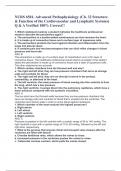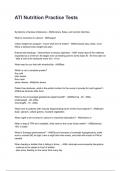Exam (elaborations)
NURS 6501- Advanced Pathophysiology (Ch. 32 Structure & Function of the Cardiovascular and Lymphatic Systems) Q & A Verified 100% Correct!!
- Course
- Institution
NURS 6501- Advanced Pathophysiology (Ch. 32 Structure & Function of the Cardiovascular and Lymphatic Systems) Q & A Verified 100% Correct!! 1. Which statement made by a student indicates the healthcare professional needs to describe the pericardium again? a. The pericardium is a double-walled m...
[Show more]




